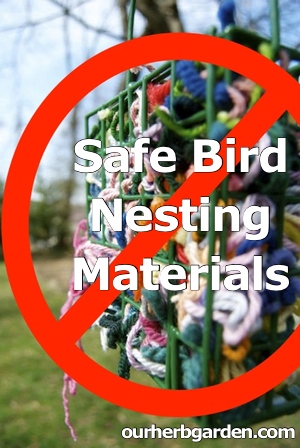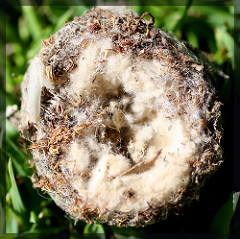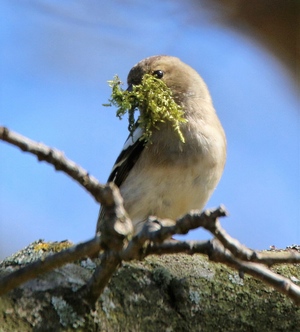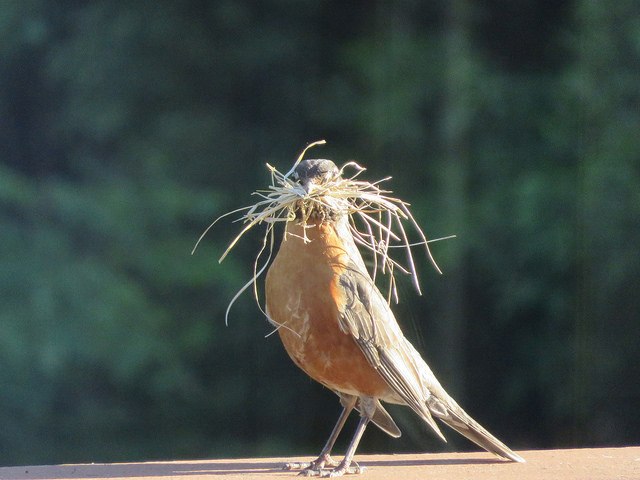 OK, who hasn’t seen the suggestion to put scraps of yarn, twine, string and even human hair out for the birds during nesting time? In principle, it sounds like a great recycling idea. Make use of the little bits and pieces that would normally be thrown out and help the birds make sturdy and comfy nests for their eggs and hatchlings. And, how fun is it to see bits of color in the nests?
OK, who hasn’t seen the suggestion to put scraps of yarn, twine, string and even human hair out for the birds during nesting time? In principle, it sounds like a great recycling idea. Make use of the little bits and pieces that would normally be thrown out and help the birds make sturdy and comfy nests for their eggs and hatchlings. And, how fun is it to see bits of color in the nests?
Our neighborhood birds never seemed too interested in our offerings. Thank goodness they were so much smarter than us!
Unsafe Bird Nesting Materials
A Facebook posting from the folks at Carolina Waterfowl Rescue quickly educated me that this act of kindness is anything but kind to our feathered friends.
Our good intentions have led to some horrendous outcomes.
Every year, the rescue organization takes in baby songbirds that have terrible injuries from these good intentions. The fibers may tangle around the bird’s legs, neck or wings. They act like a tourniquet and cut off the blood flow and cause injuries that can lead to loss of limbs and even death.
Birds and other animals can choke and have internal obstructions from eating the string.
If that’s not enough reason to not offer string-like fibers as bird nesting material, I have seen several mentions of birds getting trapped in their nests. The fibers get wrapped around the birds and literally tie them into the nest.
Think those fuzzy bits of drying lint would make a great option? That too is a bad idea. When it gets wet, it loses its shape and can leave holes in the nest. Additionally, the lint dust is bad for birds. And, if that wasn’t enough to keep you from using dryer lint for bird nesting material, think about the bleaches, laundry softeners and other chemicals that we all use to keep our clothes clean. Doubtful any of that stuff is bird-friendly.
Safe, Natural Bird Nesting Materials
So, now we know; yarn, string, twine and human hair is not appropriate nesting material for birds.
What can we offer birds as nesting material?
Here’s a list of safe suggestions for bird nesting materials.
 1. Plant things in your garden that produce fluffy seeds. Cattails are a good choice. Milkweed is an even better one. Make your own edible butterfly garden with milkweed. The butterflies love it and the birds can use the fluffy seed heads. Honeysuckle and clematis are other lovely flowers that produce fluff useful to birds building nests.
1. Plant things in your garden that produce fluffy seeds. Cattails are a good choice. Milkweed is an even better one. Make your own edible butterfly garden with milkweed. The butterflies love it and the birds can use the fluffy seed heads. Honeysuckle and clematis are other lovely flowers that produce fluff useful to birds building nests.
(wonderful hummingbird nest photo from Flickr user tinyfroglet)
2. When you start filling this year’s hanging baskets, offer the birds the worn-out coco fiber linings as bird nesting material.
 3. Natural fibrous materials like sphagnum and Spanish moss make bird great nesting material. The focus here is on natural fibers. Don’t dyed, chemically preserved or otherwise chemically treated materials. (female chaffinch gathering moss for its nest photo from Nick Goodrum.)
3. Natural fibrous materials like sphagnum and Spanish moss make bird great nesting material. The focus here is on natural fibers. Don’t dyed, chemically preserved or otherwise chemically treated materials. (female chaffinch gathering moss for its nest photo from Nick Goodrum.)
4. Doing any spring cleaning this year? Perhaps you have an old down jacket, pillow or quilt that has seen better days? Recycle the feathers by providing your backyard friends with some natural nesting materials. (While the folks at the rescue did not say so, I’m thinking those colorful dyed craft feathers would probably not be a good idea here. I also wonder if the item has been dry cleaned, if it would be better to not offer it to the birds as there are harsh chemicals used in the dry cleaning process.)
5. Natural fiber quilt batting makes good nesting material too. Scraps of wool or cotton batting cut into 3″ – 6″ strips provide a safe and comfy nesting material. Several folks mentioned using strips of cloth. I wouldn’t. Too many threads that could unravel and become a threat.
UPDATE: Thanks to Sharon, I am removing the suggestion of offering wool scraps as nesting material. Apparently, it can felt in warmer temperatures.
6. Animal fur. Do you have a fur baby? When you brush them, save the loose fur for your bird friends. Just don’t share pet fur that has been treated with flea dips or other insect repellents.
 7. Yard debris. Pine straw, wheat straw, small/tiny twigs (anything under 4 inches is particularly useful to most backyard birds) and even grass clippings (untreated with chemicals) make great natural bird nest material. (Kaarina Dillabough graciously shared this lovely robin photo)
7. Yard debris. Pine straw, wheat straw, small/tiny twigs (anything under 4 inches is particularly useful to most backyard birds) and even grass clippings (untreated with chemicals) make great natural bird nest material. (Kaarina Dillabough graciously shared this lovely robin photo)

I have seen a Woodpecker die from having a piece of string caught on its barbed tongue. It couldn’t retract its tongue which froze. He didn’t live long after I found him. I’ve also found the skeleton of a Raven fledger in its nest with fishing leader entangling its leg.
Oh Terry, how sad. We have a little resident woodpecker and marvel at how hard he works for his food. Would crush us to find him that way.
Thank you for stopping by and sharing your stories. So many people, like us, thought we were helping our feathered friends by putting out yarn and hair; when instead, we were putting them at risk of injury and death.
I put some undyed wool fleece out one day – didn’t touch it. However, they use to fight over the hen feathers when we had chickens – only the little down feathers though. They picked up the larger flight feathers – measured it up and discarded it. It was great to watch.
I read one post elsewhere where a lady found a nest where wool fibers from the batting had felted from the heat and motion of the chicks and had entrapped the feet of some of the nestlings. They died because they could not leave the nest.
I can’t find anywhere online where dog hair has done this. That is what I have to put out.
Anyone else with experience on this topic?
I think I had seen someone mention wool roving was a good choice. I’m so glad you shared the story you found about it felting.
I’m not entirely sure about pet hair. I think one expert said to not put out hair that was any longer than an inch. Can’t remember where I saw that though. I originally would have suggested if it’s short and doesn’t naturally felt (I think poodle fur felts and some cat fur does too) that it might be OK.
But, after so many folks sharing how good intentions have had dire consequences, I guess it’s just better to either provide piles of small twigs or just leave our feathered friends to their own devices.
I agree so much information out there, i never know whats good info, I think Ill just gather twigs and leaves from the woods by my house and see if they use that.
Ours like pine straw too. But, I would think a small pile of little twigs and leaves would be much appreciated by your feathered neighbors.
I just recently read an article that animal fur may not be a good choice due to flea medications that penetrate the skin and also the hair folicles. It can’t be good for the birds. We really have to be cautious about our good deeds, and be sure they are safe.
I have a lot to learn.
Thank you, Michele, for your input. That is the conclusion I have come to as well. I have a ‘loosely kept’ yard and there is plenty of natural material out there for the birdies. I help them out with seeds and suet and I will have to be content with that.
Can I use the fibres from inside a hanging planter basket, for nesting material for a parrakeet
Not sure, but, I would definitely check to see if it easily breaks before using it.
This sounds like the wisest choice, thank you! I was going to ask about alpaca hair, but I think I also will content myself with putting out dried bugs and planting bird-friendly vegetation. It already helps that I use zero pesticides or man-made fertilizers to protect their natural source of plants, insects, microbes, etc.
Orioles got in my shed and we’re stealing kite string. They had a long string strewn out and over the door. Probably 15 feet! I didn’t know it was bad so I just cut it up and left it for them. I will definitely find something from the suggestions here and put out instead. And I’ll get that string out of the shed so they can’t be tempted.
Oh my goodness, that must have been so much fun to watch. Years ago, we would have probably just made it easier for them to have it too. So glad I saw that article and have been able to share it with everynoe.
Hi guys, am I glad I’ve read your recommendations. I was going to purchase natural un-dyed CARDED sheep’s wool as possible nesting material. Would you agree, that this is not suitable (please confirm and why)?? What about Barley Straw, would that be o.k.? Your advice would be greatly appreciated. Many thanks, Carola.
I think that the wool would be better than yarn but I’ve seen some carded roving that had pretty long fibers. I think I would err on the side of caution and not use it. But, the National Wildlife Federation does suggest using wool. I guess a good middle ground would be to examine it carefully and cut any longer pieces.
Seems like the barley straw would be OK. I would just be worried that it was treated with pesticides.
As others mentioned, I read that items like wool, and sometimes other pet/animal hair can felt up from moisture and the chicks’ movement. Chicks were found dead with their feet stuck to the nest because the wool felted and they were adhered to it. I found this site looking to see if alpaca hair was safe (I see alpaca farmers advertising it for nests) but I think it may have the same problem and so I won’t risk it.
I was watching orioles trying to pull apart plastic bale twine (for hay and straw bales), and while I’ve seen it in old nests I would rather something else be used. Was wondering about length of animal feed bag, white string used to close the bag, cut to perhaps one foot lengths for cardinals.
I’ll cut some long, narrow-leaf grass with my scythe as a natural nesting material as well for a test !
Anything string-like shouldn’t be longer than about an inch. I bet they would love using the grass.
I’ve seen people say use plastic bags, straws etc.
And found out that over hundreds of birds die from plastic
DO THEY WANT THE BIRD POPULATION TO DIE!!!!!!!!!!
Hi, so if I am reading this right,,any grass or straw pieces should be no longer than 6 inches .. I have broom straw I was going to cut to add to a basket for them this Spring
Shorter is always better.
I bought a pack of Spagnum moss from the Dollar Tree ($1.00) to put in my indoor finch cage. They love it. I cut it up so there aren’t really long strands that can cause a problem. Will probably offer some to the wild birds this year as well. Perhaps put it in a suet feeder? I have bluebird boxes. I read that it is good to clean them out at the end of the season they don’t harbor mites, etc. Bluebirds can have 3 clutches per season.
I have seen large grackle bird nests where they used strips of black plastic to weave and secure their nest, which lasted years. I don’t give them anything, because they have so much to choose from. I leave it up to them to choose. I had some dragonfly lights in a small redbud tree, where a cardinal built a nest last spring. Sadly, some critter either ate the eggs or babies. I have no idea what happened. It broke my heart. Cycle of life.
How about pillow stuffing? Polyfill, is that ok to use?
I wouldn’t try it. Some of those fibers are pretty long and very hard to break.
Thank you for the information. I was going to save the hair that I brushed out since the only thing I have ever used on it is castile soap, I’m so glad I took the time to check.
Great post! Will share with friends!
I had an old down pillow. They loved the feathers. Caution: open down outside as the feathers go everywhere.
Love this idea! Thanks for sharing it.
Dryer lint is not recommended because it can lose its shape and develop holes when it gets wet. What about the polyester fluff found in stuffed animals that have seen better days? Thanks for your reply.
Dryer lint seems to be one of those debated materials – some say it makes nice soft downy bedding, others say it will not stand up to wind or rain. We don’t put it out. As to the polyester fluffy stuff – I wouldn’t recommend it at all. I work with that stuff all the time. It can have very long strings and they are very hard to break.
Agree. I would not put out stuffing or polyester pillow fill.
as I watch my dogs un-stuff their Christmas gifts would that stuffing be OK to put out for the birds?
Sorry, I’m so late with my reply. I wouldn’t. The fibers are often quite long and they are generally made from plastic and other chemicals.
Great article and comments! I was wondering about a cotton wreath. I’ve seen them made with cotton balls but I was looking for real cotton. Then I thought about all the poisons sprayed on cotton and decided against it. Boo!
Perhaps plant some? Or maybe a little milkweed? The butterflies would enjoy that too.
PLEASE STOP EXPOSING WILDLIFE(and living things in general) TO TOXIC MATERIALS: PLASTIC! (Polyester, polyfill, straws, netting, fishing line, bags etc). Dryer lint is toxic to birds because of the strong chemical compounds in detergents. Even natural detergents like borax can kill a small bird. It is likely to be accidently or deliberately ingested by birds, or tangle their young. If it is unsafe for you or an infant to eat, it doesn’t make sense to expose that possibility to even smaller birds.
*HAIR (from humans, “pets” or other animals) can be risky because each animal has different mircorganisms that live on the skin and hair to maintain the condition of the skin, and in different numbers. The balance(number, combination) of beneficial and destructive mites/bacteria varies from each individual animal. Some mites can infest the airways, skin, and eyes of a bird and kill it. Most are only visible on a microscope,so you’re not going to be able to “check” and see if there are skin, hair, dust, or soil mites before sending the hair as nesting material to a bird.
*I am going to try Sphagnum Moss: boiling it to sterilize any bacteria/bugs/mites/fungus in an uncoated stainless steel pot(teflon and coatings like it kill birds), rinsing and letting any other debris float to the top and separating it from the moss. Then I’m going to spread it out thinly on a baking sheet or something like itso it can dry in a way that doesn’t encourage mold spores to grow, or the hold moisture too long to start decaying and attracting any household gnats that can lay eggs, etc.
*When buying STRAW as nesting material, I recommend getting natural or organic from a pet store or co-op that is in a sealed plastic bag without any holes, because that is more likely to suffocate any lifeforms(mites) that may harm your birds.
*opt for dust-free, to avoid risk of respiratory complications with your birds.
*Hay and grass tend to contain grasses with rough barbs on the leaves that can itch and irritate your birds skin and they may get a rash or simply avoid it as nesting material (learned from this mistake)
What can work: ORGANIC MATERIALS(nothing from store-bought, non-native houseplants that you dont see wild birds already using naturally, as although beautiful, can be toxic to birds- without doing research- and expose wild or captive birds to soil mites): COCONUT FIBER(not soil); untreated/dye-free SHREDDED PAPER(like clean egg carton cardboard) non-chemically sterilized STRAW & moss, natural, non-toxic fibers an inch or shorter that can be easily broken/digested by a bird if need be, and anything else that fits the rules to avoid risk of infection or injury(when eaten, touched, wrapped, or inhaled) to a pathogen or parasite.
*I am mostly referring to pet birds(finches). As for wild birds, it is best to watch, enjoy, and not interfere with their process. They know what they are doing, where to get materials if not in an urban area, and likely dont need help doing bird things<3
It is truly amazing the intelligence and resilience of animals that humans would lack if put in the wild and ask to build a nest and eat the right bugs, seeds, leaves and berries!
GOOD LUCK, and have fun bird watching!
Wow! Thank you K for so much information! I think it’s just human nature to want to help our feathered visitors. Sadly, sometimes our “help” isn’t really help at all.
Are cotton balls ok? Do they have chemicals? Thanks
I was originally going to suggest instead of using store bought cotton balls to try growing your own. A little research on growing cotton led me to learn that growing cotton in backyard gardens is banned in quite a few states.
Thanks for the info. I thought maybe the tiny all cotton quilt scraps I had would be good but now won’t put them out. Sounds like it’s better to just let nature be natural.
It seems like so much of the stuff we had done for years may not have been so good after all. sigh
We had a robin trying to untangle the netting we used to allow our clematis to grow up our fencing. Stinkers. This was super helpful info.
It’s not bad enough trying to fight off the rabbits and deer but stealing netting is really cheeky. Fun story. Thanks for sharing and the kind words.
What about the cotton in supplement bottles? Is that safe?
It’s amazing how wild life manages to find things. We had a small tub full of twigs under our front porch chair for dry kindling in our little camp stove. At least 1/3 of our collection has been absconded with by the feathered residents of our yard. (They made a bit of a mess, and we’ve actually caught a few in the act.)
I’ve just seen too many horror stories about humans, in their desire to be helpful, have harmed their backyard guests. We’ll continue giving out water, bird seed and sugar water. But, anything else from inside the house, is going to stay inside. We do replenish the tub with twigs and will sometimes pile others. Just be sure you don’t create the perfect hunting ground for hawks or other predators.